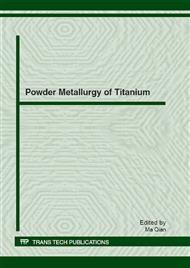[1]
W. Kroll, Verformbare Legierungen des Titans, Z Metallkunde 29 (1937) 189-192.
Google Scholar
[2]
M. Qian, Cold compaction and sintering of titanium and its alloys for near-net-shape or preform fabrication, Int. J. Powder Metall. 46 (5) (2010) 29-44.
Google Scholar
[3]
T. Saito, The automotive application of discontinuously reinforced TiB-Ti composites, JOM 56 (2004) 33-36.
DOI: 10.1007/s11837-004-0125-3
Google Scholar
[4]
M. Qian, Powder metallurgy of titanium at the 12th world conference on titanium, Materials China, 30 (8) (2011) 50-53.
Google Scholar
[5]
Anon., Dynamet technology approved by Boeing as qualified supplier for Powder Metallurgy titanium alloy products, http: /www. ipmd. net/news/001695. html [Accessed 10 May 2012].
Google Scholar
[6]
B.Y. Chen, K.S. Hwang, K.L. Ng, Effect of cooling process on the a phase formation and mechanical properties of sintered Ti–Fe alloys, Mater. Sci. Eng. A. 528 (2011) 4556-4563.
DOI: 10.1016/j.msea.2011.02.092
Google Scholar
[7]
Y. F. Yang, S. D. Luo, G. B. Schaffer, M. Qian, The sintering, sintered microstructure and mechanical properties of Ti-Fe-Si alloys, Metall. Mater. Trans. A DOI: 10. 1007/s11661-012-1272-8.
DOI: 10.1007/s11661-012-1272-8
Google Scholar
[8]
L. Zhang, X. Wang, X. Qu, Application Status and Market Analysis of Non-Aero Titanium in China, Key Engineering Materials 520 (2012) 8-14.
DOI: 10.4028/www.scientific.net/kem.520.8
Google Scholar
[9]
Y.F. Yang, S.D. Luo, G.B. Schaffer, M. Qian, Sintering of Ti–10V–2Fe–3Al and mechanical properties, Materials Science and Engineering A 528 (2011) 6719– 6726.
DOI: 10.1016/j.msea.2011.05.041
Google Scholar
[10]
Y.F. Yang, S.D. Luo, C.J. Bettles, G.B. Schaffer, M. Qian, The effect of Si additions on the sintering and sintered microstructure and mechanical properties of Ti–3Ni alloy, Materials Science and Engineering A 528 (2011) 7381– 7387.
DOI: 10.1016/j.msea.2011.06.029
Google Scholar
[11]
M. Marty, H. Octor, A. Walder, US Patent 4, 601, 874 (1986).
Google Scholar
[12]
E.I. Larsen, E.F. Swazy, L.S. Bush, R.H. Freyer, Properties of binary sintered and rolled titanium alloys, Metal Progress 55 (1949) 359-361.
Google Scholar
[13]
T. Saito, A cost-effective P/M titanium matrix composite for automobile use, Adv. Performance Mater. 2 (1995) 121-144.
DOI: 10.1007/bf00711267
Google Scholar
[14]
O. M. Ferri, T. Ebel, R. d. Bormann, The influence of a small boron addition on the microstructure and mechanical properties of ti-6al-4v fabricated by metal injection moulding, Adv. Eng. Mater. 13 (2011) 436-477.
DOI: 10.1002/adem.201000280
Google Scholar
[15]
T. Saito, Ti-B alloy for automobile use - remaining issues, presentation at A Workshop on Titanium Alloys Modified with Boron, Dayton, OH, 11-13 October, (2005).
Google Scholar
[16]
H. Miura, The influence of density and oxygen content on the mechanical properties of injection molded Ti-6Al-4V alloys, in Advances in Powder Metallurgy & Particulate Materials – 2010, Metal Powder Industries Federation (MPIF), 2010, 46-53.
Google Scholar
[17]
T. Ebel, O. M. Ferri, W. Limberg, M. Oehring, F. Pyczak, F. -P. Schimansky, Metal injection moulding of titanium and titanium-aluminides, Key Engineering Materials 520 (2012) 153-160.
DOI: 10.4028/www.scientific.net/kem.520.153
Google Scholar
[18]
Y. Liu, Y. Liu, B. Wang, H. Tang, Rare earth element: Is it a necessity for PM Ti alloys? Key Engineering Materials 520 (2012) 41-48.
DOI: 10.4028/www.scientific.net/kem.520.41
Google Scholar
[19]
M. Yan, Y. Liu, Y.B. Liu, C. Kong, G.B. Schaffer, M. Qian, Simultaneous gettering of oxygen and chlorine and homogenization of the β phase by rare earth hydride addition to a powder metallurgy Ti-2. 25Mo-1. 5Fe alloy, Scripta Mater. (2012).
DOI: 10.1016/j.scriptamat.2012.06.009
Google Scholar
[20]
M. Qian, G.B. Schaffer, Sintering of aluminium and its alloys, In: Sintering of Advanced Materials, Z. Z. Fang (Ed. ), Cambridge, Woodhead Publishing, 2010, pp.289-322.
DOI: 10.1533/9781845699949.3.291
Google Scholar
[21]
W.B. James, G.T. West, Ferrous Powder Metallurgy Materials, in ASM Handbook, vol. 7, Powder Metal Technologies and Applications, ASM International, 2000, pp.2511-2551.
Google Scholar
[22]
C. H. Caceres, G. E. Mann, J. R. Griffiths, Grain size hardening in Mg and Mg-Zn solid solutions, Metall. Mater. Trans. A 42A (2011) 1950-(1959).
DOI: 10.1007/s11661-010-0599-2
Google Scholar


